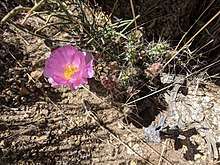Grusonia pulchella
Grusonia pulchella (Engelm.) H.Rob.[1], also known as sagebrush cholla, is a tuberous species of opuntioid cactus from the Mojave Desert of central Nevada, eastern California, northwestern Arizona and western Utah in the United States.[2] Grusonia pulchella has at various times been included in Opuntia or placed in a separate genus Micropuntia.[3]
| Grusonia pulchella | |
|---|---|
 | |
| Grusonia pulchella | |
| Scientific classification | |
| Kingdom: | Plantae |
| Clade: | Tracheophytes |
| Clade: | Angiosperms |
| Clade: | Eudicots |
| Order: | Caryophyllales |
| Family: | Cactaceae |
| Genus: | Grusonia |
| Species: | G. pulchella |
| Binomial name | |
| Grusonia pulchella (Engelmann) H. Robinson | |
| Synonyms | |
|
Opuntia pulchella, Corynopuntia pulchella, Micropuntia pulchella, etc. | |
Habitat
Grusonia pulchella grows in gravelly alluvial fans, often above salt flats or alkali basins. Specimens can be locally common, although they are difficult to locate, often growing under other shrubs such as shadscale.[4]
Description
Grusonia pulchella differs from other North American opuntioid cacti in having a geophytic habit, where above-ground growth dies back to the crown in adverse conditions, and resprouts under more favorable conditions. Authors have described the underground storage structure as a "tuberous root" or true tuber. The above-ground stems are variable, being cylindrical to globular. The areoles bear flexible yellow spines and white wool. Overall, the above-ground growth can often form a cushion-plant habit. The flowers are bright magenta, and the fruits are dehiscent. The seeds are unique, with a groove running along the hilar surface.[5]
Synonymy
- Grusonia pulchella (Engelm.) H.Rob., Phytologia 26: 176. 1973.
- Opuntia pulchella Engelm., Trans. Acad. Sci. St. Louis 2: 201. 1863.[6]
- Micropuntia pulchella (Engelm.) M.P.Griff., Haseltonia 9: 91. 2003.[7]
- Corynopuntia pulchella (Engelm.) F.M.Knuth in Backeb. & F.M.Knuth, Kaktus-ABC [Backeb. & Knuth] 115. 1936.[8]
- Micropuntia brachyrhopalica Daston, Amer. Midl. Naturalist 36: 661, fig. 1. 1946.[9]
- Opuntia brachyrhopalica (Daston) G.D.Rowley, Natl. Cact. Succ. J. 13: 5. 1958.[10]
- Micropuntia gracilicylindrica Wiegand & Backeb. in Backeb., Descr. Cact. Nov. 9. 1956.
- Opuntia gracilicylindrica (Wiegand & Backeb.) G.D.Rowley, Natl. Cact. Succ. J. xiii. 5. .1958.
- Micropuntia pygmaea Wiegand & Backeb. in Backeb., Descr. Cact. Nov. 9. 1957.
- Opuntia pygmaea (Wiegand & Backeb.) G.D.Rowley, Natl. Cact. Succ. J. 13: 5. 1958.
- Micropuntia barkleyana Daston, Amer. Midl. Naturalist xxxvi. 662, fig. 2. 1946.
- Micropuntia spectatissima Daston, Amer. Midl. Naturalist xxxvi. 662, fig. 3. (1947).
- Opuntia spectatissima (Daston) G.D.Rowley, Natl. Cact. Succ. J. xiii. 5. 1958.
- Micropuntia tuberculosirhopalica Wiegand & Backeb. in Backeb., Descr. Cact. Nov. 9. 1957.
- Opuntia tuberculosirhopalica (Wiegand & Backeb.) G.D.Rowley, Natl. Cact. Succ. J. 13: 5. 1958.
- Micropuntia wiegandii Backeb., Descr. Cact. Nov. 9 (1957).
- Opuntia wiegandii (Backeb.) G.D.Rowley, Natl. Cact. Succ. J. 13: 5. 1958.
References
- H.Rob., Phytologia 26: 176. 1973.
- http://www.cactus-art.biz/schede/MICROPUNTIA/Micropuntia_pulchella/Micropuntia_pulchella_barkleyana/Micropuntia_barkleyana.htm
- Anderson 2001, p. 346
- http://heritage.nv.gov/taxon_detail/15920
- Flora of North America, vol 4. 2004.
- Engelmann, Trans. Acad. Sci. St. Louis 2: 201. 1863.
- Griff., Haseltonia 9: 91. 2003.
- Backeb. & Knuth, Kaktus-ABC 115. 1936
- Daston, Amer. Midl. Naturalist 36: 661, fig. 1. 1946.
- Rowley, Natl. Cact. Succ. J. 13: 5. 1958.
Bibliography
- Anderson, Edward F. (2001), The Cactus Family, Pentland, Oregon: Timber Press, ISBN 978-0-88192-498-5